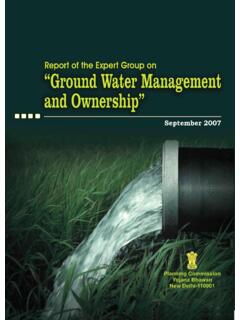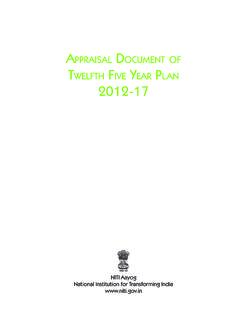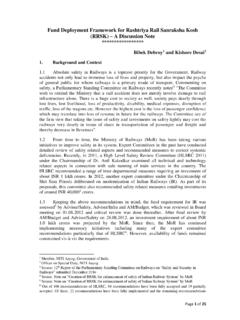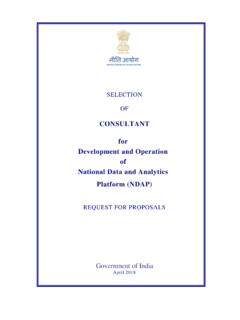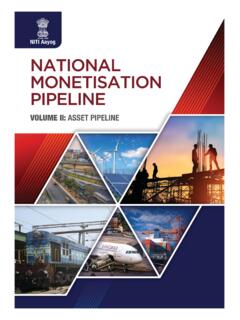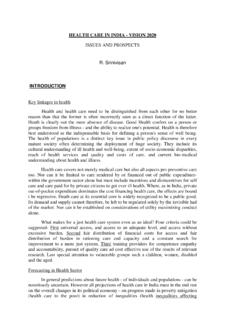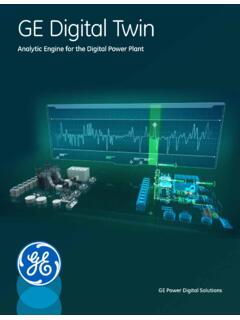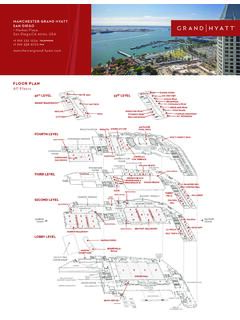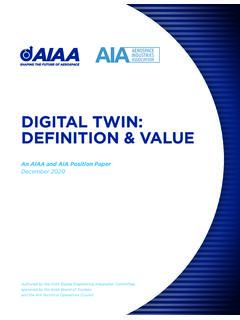Transcription of TRANSFORMING INDIA’S MOBILITY - NITI Aayog
1 TRANSFORMINGINDIA S MOBILITYA PersPectiveSEPTEMBER 2018 TRANSFORMING INDIA S MOBILITYA PERSPECTIVEAUTHORS & ACKNOWLEDGEMENTSTHE BOSTON CONSULTING GROUP (BCG)Rahul Jain Ritesh RitoliaNatarajan SankarJanmejaya SinhaCONTACTS:NITI Aayog : views & opinions expressed in this document are those of the authors and do not necessarily reflect the positions of the institutions or governments. While every effort has been made to verify the data and information contained in this report, any mistakes and omissions are attributed solely to the authors and not to the organization they AAYOGS hikha Juyal Abhishek SaxenaShweta SharmaAnil SrivastavaAUTHORSThe authors would like to thankDr.
2 Rajiv Kumar, Vice Chairman, NITI Aayog and Mr Amitabh Kant, CEO, NITI Aayog for their support that made this report CITATIONS:NITI Aayog & The Boston Consulting Group, TRANSFORMING India s MOBILITY : A perspective, 2 EXECUTIVE SUMMARY 6 CONTEXT AND APPROACHF igure A: Indexed estimated growth in travel demand (1980=100)Figure B: Heat-map of Air Pollution Concentration in the WorldFigure C: Pollution level in Major Indian Cities (PM Level)Figure D: PM Level increase across Major Countries (1990-2015)Figure E: Cost of Congestion for Top Indian citiesFigure F: TRANSFORMING India s MOBILITY 3C Framework 12 SAFE, ADEQUATE AND HOLISTIC INFRASTRUCTURE (SAHI) 16 PEAK TIME TRAVEL OPTIMIZATIONF igure G: Traffic index- Peak hour congestion (% additional time to travel in peak hours) 20 LOGISTICS AND GOODS TRANSPORTF igure H: Relatively high urban freight costs compared to long distance transport cost 24 SEAMLESS, CONVENIENT PUBLIC TRANSPORTF igure I.
3 Number of buses per 1,000 population across countries & Indian states 27 SHARED MOBILITY 29 NON-MOTORIZED TRANSPORTF igure J: Share of Non-Motorized Transport in cities as a % of overall modal trips 32 GREEN MOBILITY TECHNOLOGIESF igure K: EV Sales and Penetration across the World 34 OVERARCHING STRATEGIC ENABLERS2 | TRANSFORMING India s MobilityEXECUTIVE SUMMARYThe rapid growth in India s urbanization, population and wealth over the last few decades has had a marked effect on the MOBILITY of its citizens. India s transport demand has grown by almost 8 times since 1980 more than any other Asian economy1.
4 This large growth has been positive in many ways, including development of a thriving auto industry and allied economic growth. However, there are a set of challenges to be addressed. A recent WHO study has fourteen Indian cities featuring in the top fifteen most polluted cities in the world2. This challenge leads to significant health and welfare losses, currently estimated by the World Bank at of India s GDP (PPP adjusted). Additionally, major Indian cities are also now consistently ranked amongst the world s most congested cities. The average speed for vehicles in some metros are reported as low as 17 km/h3.
5 These high levels of congestion have huge cost in form of reduced productivity and fuel waste; a high-level estimate of the economic loss of congestion, for our top four metros, is over USD 22 billion annually4. It is worthy to note that multiple efforts at the city, state and national level have been made to alleviate these challenges. For rural India, the Pradhan Mantri Gram Sadak Yojana (PMGSY) is perhaps the best example. The reinvigoration of this scheme in the last 3 years has led to record highs of building all-weather roads at a rate of 130 km/day5.
6 For urban India, in order to address the twin challenges of pollution and congestion, a number of initiatives have been launched. At the national level, multiple policies such as the National Urban Transport Policy & the National Electric MOBILITY mission Plan 2020 have been designed as well. While there are multiple examples of such initiatives, the magnitude and complexity of our MOBILITY challenges requires a comprehensive action-agenda that addresses the issue holistically. The high population density, growth, coupled with our economic growth aspirations warrants a tailored approach, unique to our an exhaustive study of global examples and learning from India s past efforts, a holistic framework for TRANSFORMING India s MOBILITY is proposed, as detailed in the figure.
7 Niti Aayog | 3 The crown of the framework defines the overall objectives (3C) Clean: Pollution-free, leading to clean air and hence better health and living standards Convenient: Seamless, safe, affordable, accessible for all sections including the elderly & disabled and connected both in terms of technology as well as connecting key rural and urban centers Congestion-free: Minimum congestion levels, and hence enhanced economic efficiency To achieve the objectives, following action-agenda is advocated around four key pillars, namely, (a) Connect Bharat, (b) Optimize travel footprint, (c) Promote seamless, co-operative transport, and (d) Adopt green modes and technologies.
8 These pillars have to be well supported by a common set of enablers Skills and employment, Intelligent Transport Systems, Public Awareness, Governance and BharatOne clear imperative for our MOBILITY paradigm is to build Safe, Adequate and Holistic Infrastructure (SAHI) for all our citizens, including women, elderly and disabled. Also, the infrastructure network needs to solve for all types of connectivity - urban-to-urban, urban-to-rural and rural-to-rural. Multiple current schemes such as Pradhan Mantri Gram Sadak Yojana (PMGSY), Pradhan Mantri Jal Marg Yojana (PMJMY)
9 , and UDAN (Ude Desh ka Aam TRANSFORMING India's MOBILITY 'Clean, Convenient & Congestion free'Skills & employment Intelligent Transport Systems Public awareness GovernanceOverarching strategic leversPromote Seamless, public transportSeamless & convenient public transportShared mobilityAdopt green modes & technologiesNon-motorized transportGreen MOBILITY technologiesOptimizetravel footprint'Peak-time' travel optimization Logistics and goods transportConnecting Bharat Building Safe, Adequate, Holistic Infrastructure (SAHI)4 | TRANSFORMING India s MobilityNaagrik).
10 There is a need for continued action and focus on this, aided with few elements as detailed below. Increased emphasis on safety and accessibility Leveraging multiple modes of transport road, rail, coastal and inland waterways, small regional airports, ropeways etc. Higher usage of data for holistic MOBILITY needsOptimize Travel FootprintAnother focus area is to reduce congestion caused by passenger and goods flow, especially in urban context. This reduced congestion would also significantly help the cause of clean air. Our cities have one of the highest peak-time congestion amongst Asian cities - our citizens spend almost additional time in peak traffic for our top four metros, compared to for Singapore and Hong Kong6.
